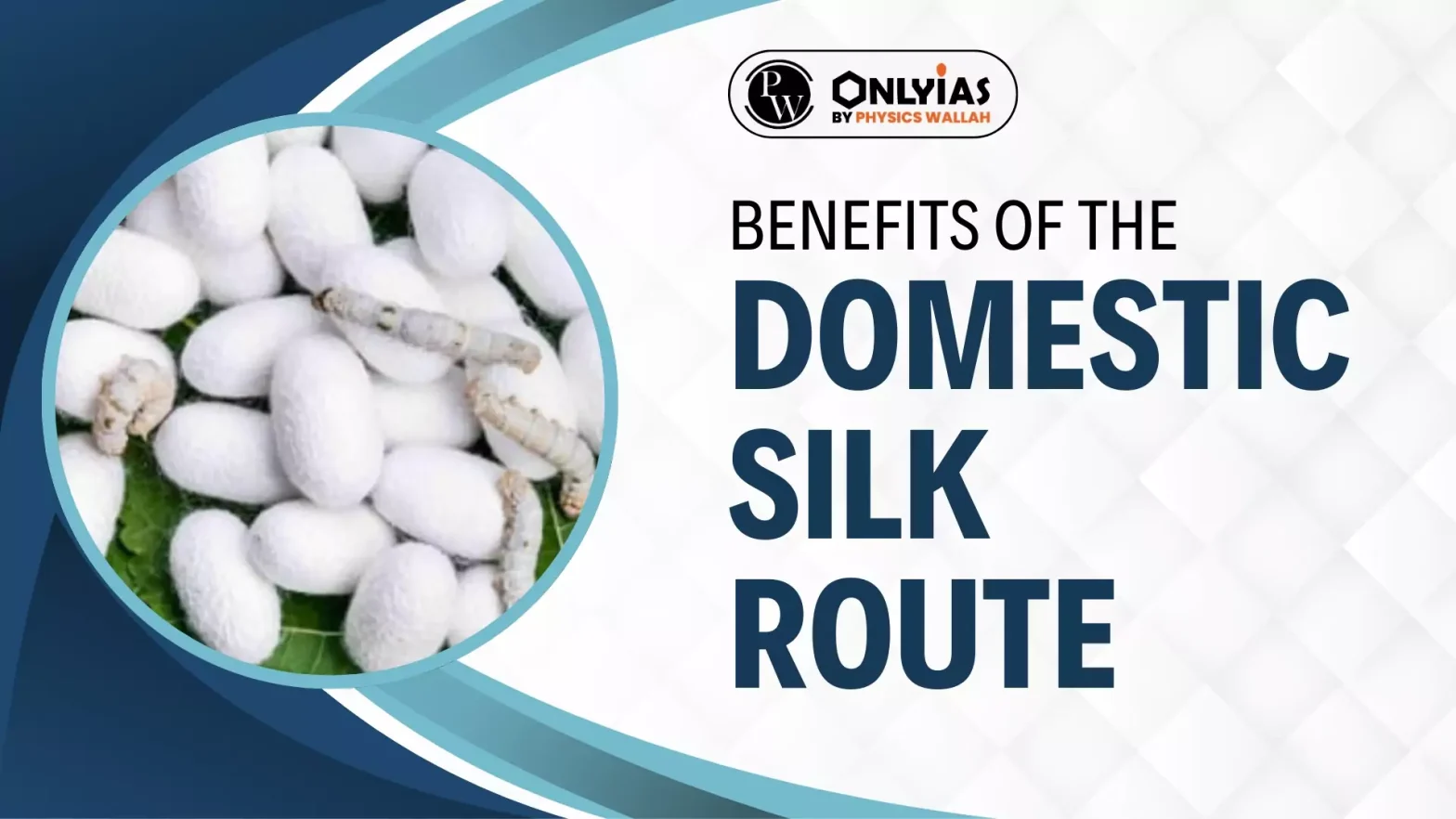India seems set to become the world’s leading producer of silk and silk products by 2030.
| Relevancy for Prelims: Fiber Crops In India, Sericulture, Types of Silk, Production in Silk, Initiatives to boost Sericulture Market , etc.
Relevancy for Mains: Sericulture, Process of Silk Production, Types of Silk, Silk Production in India, Challenges, Initiatives to boost Sericulture Market , etc. |
About Sericulture
Sericulture is the cultivation of silkworms to produce silk.
Here’s an overview of the process:
- Selection of Silkworm Eggs: High-quality silkworm eggs are selected from a healthy breed. These eggs are incubated under controlled conditions to hatch into larvae.
- Hatching: The eggs hatch into tiny silkworm larvae, which are then placed on trays with a clean and hygienic environment.
- Feeding: The larvae are fed fresh mulberry leaves several times a day. This feeding process continues for about 4-6 weeks, during which the larvae undergo several molting stages (shedding their skin).
- Spinning the Cocoon: After the final molting stage, the silkworms spin cocoons. Each silkworm produces a single long filament by secreting a proteinaceous substance called fibroin, which hardens on exposure to air to form silk. This process takes about 2-3 days.
- Stifling: To kill the pupae inside and prevent them from breaking the cocoon, the harvested cocoons are subjected to heat treatment. This process is known as stifling and can be done using steam, hot air, or sun drying.
Enroll now for UPSC Online Classes
Types of Silk
India is a unique silk producer in the world because four types of silk are produced here:
- Mulberry silk: This is the most common type. It is produced by domesticated moths called Bombyx mori, which feed on mulberry leaves. It has a strong, fine texture and is glossy, making it perfect for sarees.
- Muga silk: This is a special golden-colored silk made from wild silkworms (Antheraea assamensis) found in Assam. It is highly valued for its shine and durability.
- Eri silk: Also known as ‘Ahimsa silk’ because the silkworms are usually not killed in the process. It is mainly produced in the northeastern states from Samia ricini moths that feed on castor leaves.
- Tussar silk: This is a weather-proof material – cool in summer and warm in winter. It is mainly produced in states like Bihar, Madhya Pradesh, and Odisha.
- Tussar silk, mentioned in ancient Sanskrit texts as Kosa, is virtually a weather-proof material, as the garments made from it remain cool in summer and warm in winter.
Silk Production in India
- Becoming the Number 1: The annual production of silk, estimated at 36,500 tonnes in 2022-23, is projected to surge to more than 50,000 tonnes by 2030, and surpass that of China, the world’s largest silk producer.
- Growing Market: According to silk-industry sources, the sericulture market, estimated at worth over Rs 53,000 crore in 2023, is expected to exceed Rs 2 trillion by the early 2030s, registering a robust annual growth rate of over 15 per cent.
- Producers State wise: Apart from the major silk-producing states like Karnataka, Andhra Pradesh, West Bengal, and Tamil Nadu, and the Union Territory of Jammu and Kashmir, some smaller players in this sector, such as Uttar Pradesh and Maharashtra, have also drawn up ambitious plans to promote sericulture
Challenges Related to the Silk Production in India
- Lack of Technological Advancement: Insufficient investment in research and development hampers the adoption of new technologies and practices that could improve productivity and disease resistance in silkworms
- Huge Domestic Demand: Indian sericulture exports may follow an unpredictable trajectory due largely to the huge domestic demand for silk products, which is growing faster than indigenous production.
- Even now India has to import about 4,000 tonnes of silk annually to meet the requirements of the silk-based industry.
- Limited Exports: So, regardless of the anticipated rise in domestic silk output, the availability of silk for exports may remain limited, and continue to fluctuate, as has been the case in the recent past.
- In 2021-22: the country exported silk and its products worth around $248.56 million, up 25.3 per cent from the previous year’s shipments.
- In 2022-23: But these exports dipped to $220.5 million in 2022-23.
- Less Focus on By-Products: Extracting oil from silkworm pupae, which have a high content of health-boosting Omega-3 fatty acid, and also sericin, a gelatinous substance rich in protein. It is also producing mulberry juice, which has huge consumer demand.
- India is hardly exploiting the commercial potential of such products.
Check Out UPSC NCERT Textbooks From PW Store
Initiatives to boost Sericulture Market
- Modern Technology: India’s main focus now is on inducting modern technologies into this sector, where a sizable section of silk farmers is still following the age-old practices of silk production.
- Increase the production of plants: The area under mulberry, castor, and other plants, whose leaves constitute the basic feed of silkworms, is also proposed to be expanded in several states.
- Increasing the Income: More importantly, efforts are afoot to encourage gainful uses of sericulture byproducts, some of which have great commercial potential.
- This would help augment the income of silk farmers and improve the quality of silk fibre, fabric, and other products, including silk garments.
- Awareness Campaign: Though sericulture is more lucrative than many other allied fields of agriculture, its profitability can be ramped up by promoting gainful utilisation of its byproducts. Government must run an awareness campaign to educate farmers about the benefits of byproducts and using it as a lucrative alternative
![]() 23 Jul 2024
23 Jul 2024

